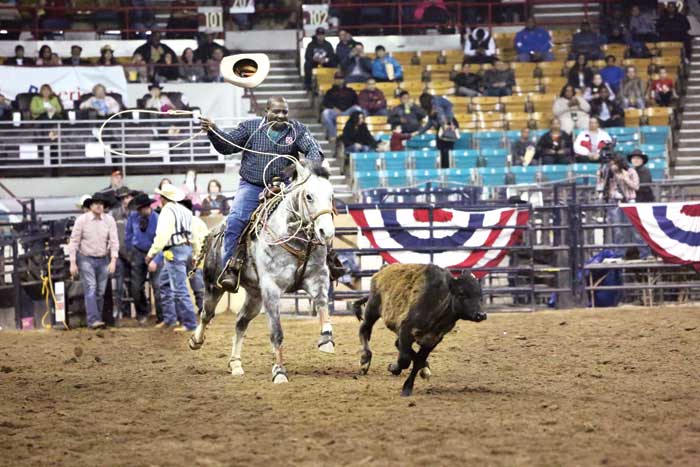
Maurice Wade competed in the calf roping event at the MLK Jr. Rodeo held during the National Western Stock Show last month. February, Black History Month, is a time to look back at the west’s rich African-American history, particularly the emergence of the Black cowboy in Colorado.
Maurice Wade wanted to be a cowboy since he was a kid. “I grew up in the cowboys-and-Indians era of movies and TV, watching Roy Rogers, the Cisco Kid and Wagon Train,” he said. “My grandfather in Mississippi had a farm and was a farrier [blacksmith]. He had two old mules I could ride. I never saw a black cowboy so I wanted to be the first one.”
Wade forgot his dream until he landed in Denver, “by way of Vietnam,” in 1970. He was brought to Fitzsimons Hospital and then got a job with the U.S. Department of Agriculture (USDA) in the quality control unit. “We visited West Yellowstone National Park and got to ride horses. It brought back my desire to be a cowboy,” he said.
Wade met Henry Lewis, an African-American cowboy. “He let me ride and taught me how to rope. I met and hung out with other cowboys and I learned about the rodeo world. It was a childhood dream realized. The next thing I knew, I was buying horses and trailers and going down the road, rodeoing.”
Since then the professional calf roper, a Montbello resident, has competed in as many as 40 rodeos a year all over the country. He still works for the USDA as well.
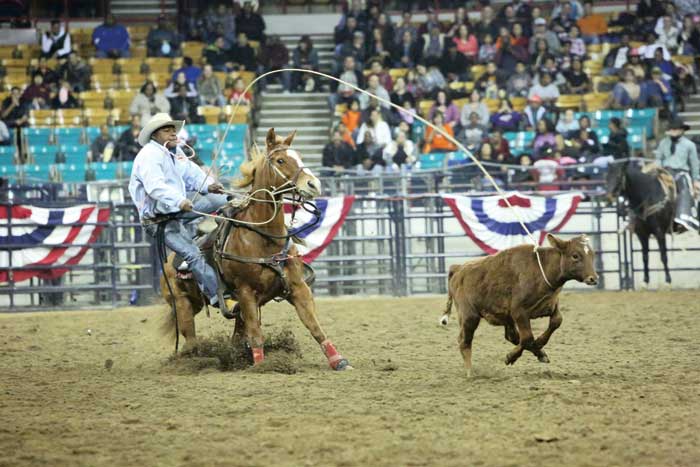
The rodeo features African-American men and women contestants who participate in traditional rodeo events like calf roping and bareback bronc riding.
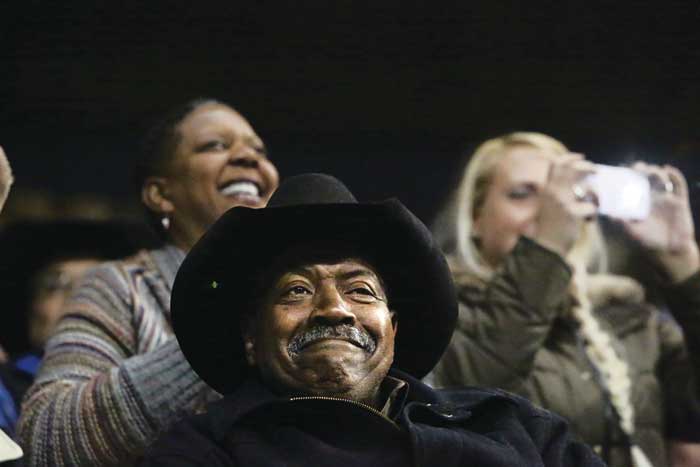
Proud attendees watched traditional rodeo events.
Beginning in 1984 he competed on the newly formed Bill Pickett Rodeo circuit, named for a black rodeo star in late 19th century Wild West shows. “When that rodeo came to town, I realized I couldn’t be the first black cowboy, and I was disappointed.”
The history of African-American cowboys captivates Wade’s interest. He presents programs on the subject to schools and government agencies to celebrate Black History Month. “I talk to people from kindergarten to age 80. I love to talk to everybody about it.”
Wade said Blacks have been cowboys since they came over on the slave ships. “The slaves on ranches broke horses, and doctored and branded cattle. The term “cowboy” referred to the youngsters who took care of the cattle. A lot of knowledge about ranch animals was gained by trial and error and sharing what they learned.”
After the Civil war the freed slaves became paid workers on ranches in Texas, Oklahoma, Arkansas and Louisiana. “Ranching work was a dirty, filthy job, but it was better than being a slave,” Wade said.
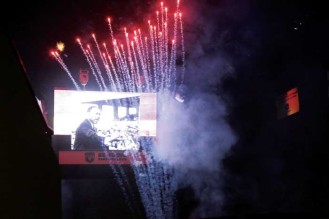
The rodeo began with an opening tribute to Dr. King.
African-Americans were instrumental in building America’s post-Civil War economy, he said. “Big cattle drives pushed the cattle from the South to the North and West to feed people. Railroads were built by blacks, Chinese and Mexican workers. America was built on the backs of people of many ethnicities. In America, despite our faults, we get along. The Civil War taught us how to tolerate one another as races.”
Some former slaves migrated west to Kansas, Colorado and Wyoming. “Some became Buffalo Soldiers, so named by the Indians for their woolly hair. Some got their own ranches, mostly in Texas,” he said.
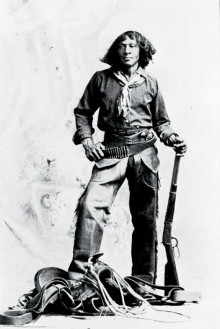
Nat Love was an ex-slave who moved west after the emancipation to become one of the most famous African-American cowboys.
Cowboy work was “one of the most integrated professions,” said Wade. “One out of three cowboys was African American.”
Being a cowboy was not easy. “Driving thousands of head of cattle across the country was hard work and they faced dangers and hardships, like outlaws trying to steal the herds and Indian attacks. They were out in all kinds of weather, getting the horses fed and blanketed. You had to have a passion for doing cowboy.”
Black cowboys who made their mark on rodeo history include Nat Love, a former slave turned adventurer, and Bill Pickett, a Wild West rodeo star.
Nat Love, born in Tennessee in 1854, came west after the Civil War freed the slaves. He learned to ride, rope and shoot in Dodge City, Kansas. Love’s multiple rodeo wins in Deadwood, S.D., earned him the nickname “Deadwood Dick.” While rounding up cattle in Arizona in 1877, Love was captured by Pima Indians, who spared his life because of his fighting ability. Love spent his later life as a Pullman porter for the Denver and Rio Grande Western Railroad.
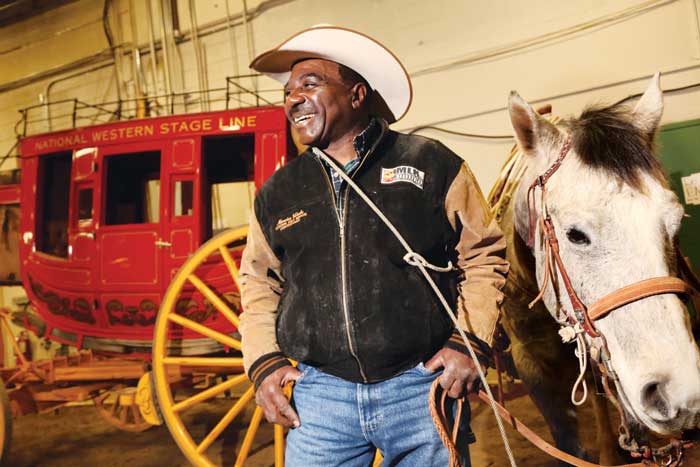
Maurice Wade waits for his event to start in the chute area during the MLK Jr. Rodeo.
Bill Pickett, the son of a former Texas slave, invented steer wrestling as a rodeo event. “He was working in Oklahoma and one steer kept breaking out,” said Wade. “Pickett saw a bulldog bite a steer on the lip so it went to its knees. So Pickett’s method, called “bulldogging,” was to bite the animal on the lip. He became a star attraction in Buffalo Bill’s Wild West Show because no one had seen that done before.
“Steer wrestling is the only event that can be traced back to a single person.”
Wade also teaches about the contributions of modern-day black cowboys, including Fred Whitfield, eight-time winner of the National Finals Rodeo World Championship in calf roping.
He said the rodeo tells the story of how America was built: “The history of rodeo is American history.”
Like the cowboys he admires, Wade keeps his passion for “doing cowboy.”
“I thought it would be romantic. I never realized the work that went into it. But I’ve endured 20 years of roping. I love the lifestyle and the people I hang out with.”
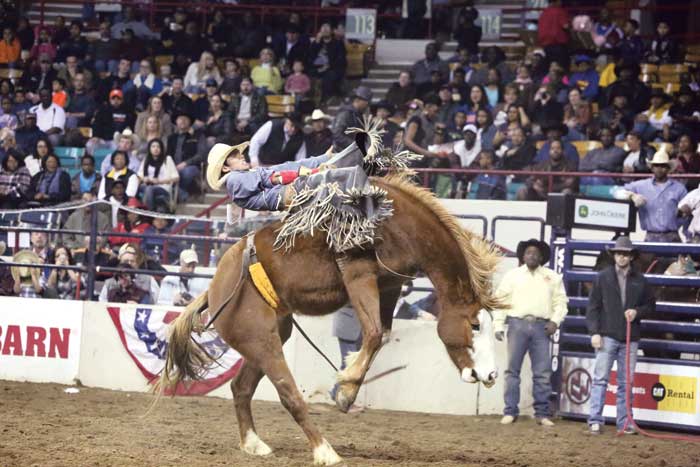
The rodeo features African-American men and women contestants who participate in traditional rodeo events like calf roping and bareback bronc riding.




Most interesting article! Great to learn the history. The excellent pictures help the reader get to know the subject.
This is a great article the front porch down and excellent job…
Nice Work – Excellent